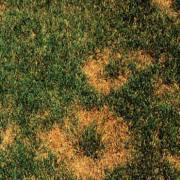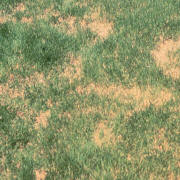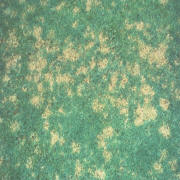|
Patch Diseases
Despite the different names, patch
diseases have essentially similar symptoms. As the names suggest, symptoms of
necrotic ring spot and patch disease include rings and circular patches of dead
or dying turfgrass. Sometimes there is a center of relatively healthy grass in
the center (frog eye) of the patch. In addition, weeds or non-susceptible
turfgrass species may colonize the centers of patches where the diseased
turfgrass has died. Both diseases are most severe on Kentucky bluegrass lawns
that were seeded or sodded two to four years previously. Symptoms often become
obvious in warm to hot, dry weather when the lawn becomes stressed. Areas along
driveways, walls, sidewalks and other places that are heat-stressed or
water-stressed will often show symptoms first.
When the disease first begins, rings or patches of blue-green wilting turfgrass
will develop in the heat of the day. With time, the patches may grow together,
obscuring the circular pattern of the damage. In lawns containing mixed
turfgrass species, symptoms are not as distinct, but circular patterns of
diseased turfgrass are generally present. Both diseases are caused by
root-infecting fungi. Above-ground symptoms may be confused with other diseases
such as brown patch disease. However, the roots and crowns of plants with
necrotic ring spot or summer patch will be brown to black and rotted.
The fungi produces very similar dark brown, microscopic threadlike filaments
that are found along the roots, crowns, and rhizomes of turf-grass. In both
diseases, infection occurs before symptoms appear. The fungi spread from plant
to plant and travel longer distances when feet and mowers spread spores, soil or
infected plant parts.
Severe damage is most common on sodded Kentucky bluegrass lawns that have been
planted on poorly prepared sites with poor drainage and compacted soil. It is
important to properly prepare a lawn site with well-drained topsoil, correct pH,
and balanced fertility. When possible, plant Kentucky bluegrass cultivars with
resistance to these diseases or consider using sod with perennial ryegrass in
the mix. This will help mask areas of infection. Similarly, overseeding with
resistant cultivars and perennial ryegrass will improve already damaged areas.
Once an area has been seeded or sodded, avoid stressful growing conditions.
There are also simple preventative measures you can take to lessen the severity
of the disease. You should water deeply without causing moisture stress. Avoid
early evening watering. Mow frequently to the recommended mowing height. It
would be a good idea to fertilize to maintain appropriate nutrient levels and
aerate to relieve compacted soils. A double aeration at right angles every
spring and fall will reduce thatch layer and stimulate a deeper, healthier root
system.
Lawn King, LLC
performs turf disease scouting when we perform each fertilizer application. If
there is a problem, we will inform you as to the type of disease, the severity
and if treatment is required. Of course, as a team, (you and I) if you notice a
problem, you should contact us immediately. |



